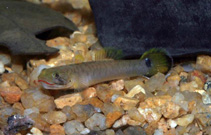| Family: |
Gobiidae (Gobies), subfamily: Gobionellinae |
| Max. size: |
3.15 cm SL (male/unsexed) |
| Environment: |
demersal; brackish; marine |
| Distribution: |
Western Pacific: China, Taiwan, Vietnam, Singapore, northern Australia; possibly also from West Malaysia and Sulawesi.. |
| Diagnosis: |
Dorsal spines (total): 7-7; Dorsal soft rays (total): 8-8; Anal spines: 1-1; Anal soft rays: 8-9; Vertebrae: 26-26. Distinguished by the following characteristics: small, slender-bodied; first dorsal fin VI, low, rounded and spines never filamentous ; second dorsal rays I/8; anal rays I/8-9; pectoral rays 16-19 (modally 18); longitudinal scales 47-50 (modally 48); TR 15-16 (modally 16); PreD 0-19 (modally 0); small ctenoid scales on body; (modally 48); predorsal area covered with cycloid scales in female, usually naked in male; naked on cheek, operculum, prepelvic region and pectoral base region; three horizontal blackish brown stripes on cheek and preoperculum; both sexes in adults with thin red lines at their upper and lower lip; adult male with caudal fin membrane yellow and distinct black margin; both sexes with caudal fin membrane having 3-5 vertical black lines (Ref. 94983). |
| Biology: |
Usually found in mangroves, at sites not far from the sea; collected by beam trawl in shallow water or by hand during low tide on mud-banks, in tiny puddles, on exposed mud surface or partly buried in mud. One specimen in the Gulf of Carpentaria was found alive among the bases of dead mangrove Bruguiera exaristata on quite dry, firm mud (Ref. 80545). |
| IUCN Red List Status: |
Not Evaluated (N.E.) Ref. (130435)
|
| Threat to humans: |
harmless |
Source and more info: www.fishbase.org. For personal, classroom, and other internal use only. Not for publication.
